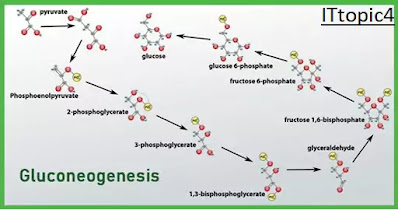GLUCONEOGENESIS
Introduction:
The production of glucose from
non-carbohydrate compound is known as gluconeogenesis. It is the metabolic pathway, our body uses to
turn non-glucose sources into glucose for energy a
life-saving pathway. Lactate, pyruvate, glycogenic amino acids,
propionate and glycerol are the major precursor of gluconeogenesis.
Definition:
Gluconeogenesis,
also called glycogenesis, formation
in living cells of glucose and other carbohydrates from
other classes of compounds. These compounds
include lactate and pyruvate; the compounds of the tricarboxylic acid
cycle,
the terminal stage in the oxidation of foodstuffs; and several amino acids.
GNG is an acronym for the term gluconeogenesis, which can define as a
metabolic pathway of synthesizing new glucose molecules from the non-glucose substrates like
lactate, TCA intermediates etc. Sometimes, it also refers as “Endogenous glucose pathway”
as it needs an input of energy. It is an anabolic process, where
the small precursor’s molecules combine to produce a high energy product like
glucose. Gluconeogenesis is an important cycle, as glucose is a “Key metabolite”
to carry out all catabolic processes and to sustain life.
 |
| GLUCONEOGENESIS |
Gluconeogenesis occur mainly in the
cytosol. About 1kg of glucose is produce every day.
Importance of gluconeogenesis:
ü Glucose is very
key substance for the metabolism and its continues supply is essential to the
body for a variety of functions.
ü Glucose is only
source that supplies energy to the Skelton muscles under anaerobic conditions.
ü Gluconeogenesis
helps in clearing certain metabolites produced in the tissues, which
accumulates in the blod, e.g. Lactate, glycerol propionate etc.
ü The degradation
of glycogen in muscles results in the formation of lactate.
ü Breakdown of
fats in adipose tissue will produce free glycerol and propionate.
ü Lactate,
glycerol, propionate and some amino acids are good precursor for glucose
synthesis.
ü Gluconeogenesis
continuously add glucose to the blood.
ü Cori cycle is
responsible for the conversion of muscles lactate to glucose in liver.
Gluconeogenesis from Glycerol:
ü On hydrolysis of
fats in adipose tissue glycerol is obtained.
ü Glycerol is
converted to glycerol-3-phosphate by an enzyme glycerokinase.
ü Dihydroxy
actetone phosphate is formed from glycerol-3-phosphate, by an enzyme called
glycerol-3-phosphate dehydrogenase.
ü Dihydroxy
actetone phosphate is an intermediates of glycolysis which can be used for the
glucose production.
 |
Importance of gluconeogenesis |
It is
a product formed as a result of triglyceride hydrolysis in the adipose
tissue and transferred to the liver via blood. Glycerol is an intermediate
which can produce glucose solely in the cytosol. It enters the cycle by two
sequential step:
Reaction of Gluconeogenesis:
ü Gluconeogenesis
closely resembles the reversed pathway of glycolysis.
ü In glycolysis
all the reactions, except three are reversible these includes;
§ Pyruvate
Carboxylase
§ Fructose-1,6-bisphosphate
to Fructose-6-phosphate
§ Glucose-6-phosphate
to Glucose
Step-1: Pyruvate Carboxylase:
ü
Pyruvate carboxylase is a biotin
dependent mitochondrial enzymes that converts pyruvate to oxaloacetate in
presence of ATP and CO2.
ü Oxaloacetate is
synthesized in the mitochondrial matrix. It has to be transported to the
cytosol to be used in the gluconeogenesis.
ü Due to membrane
impermeability, oxaloacetate cannot diffuse out of mitochondria.
ü The oxaloacetate
is firstly converted into malate and then transported to the cytosol. Within
the cytosol, the oxaloacetate is regenerated.
ü Malate
dehydrogenase is the enzyme helps in the reconversion of oxaloacetate.
 |
Pyruvate Carboxylase |
In the cytosol,
the enzyme oxaloacetate carboxykinase converts oxaloacetate to oxaloacetate.
Step-2: Conversion of Fructose 1,6-bisphosphate
to Fructose 6-bisphosphate:
ü Enzyme Fructose
1,6-bisphosphatase converts Fructose 1,6-bisphosphate to Fructose 6-phosphat.
Step-3: Conversion of Glucose 6-phosphate to
Glucose:
ü Enzyme glucose
6-phophatase catalysis the conversion of Glucose.
 |
Conversion of Glucose 6-phosphate to Glucose |











0 Comments
Thanks You....